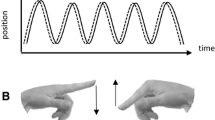Abstract
The Symbolic Play Test was given to 31 socially impaired and 29 sociable children retarded in language comprehension, with the same range of age (5 to 12 years) and intelligence (profoundly retarded to normal). Play test age and spontaneous pretend play were at a similar level in the sociable children, but, in the socially impaired, spontaneous pretend play was lower than the play test age would predict. In some of the latter it was absent, and in the others it was narrow and repetitive in form. For subgroups of socially impaired and sociable children with similar play ages, there was no significant difference in language comprehension age. The discrepancy, in socially impaired children, between levels on tests and spontaneous use of skills was discussed.
Similar content being viewed by others
References
Bartak, L., & Rutter, M. (1976). Differences between mentally retarded and normally intelligent autistic children.Journal of Autism and Childhood Schizoprenia, 6, 109–120.
Bartak, L., Rutter, M. & Cox, A. (1975). A comparative study of infantile autism and specific developmental receptive language disorder: I. The Children.British Journal of Psychiatry, 126, 127–145.
Churchill, D. W. (1978).Language of autistic children. Washington, D.C.: Winston.
Cooper, J., Moodley, M., & Reynell, J. (1978).Helping language development London: Arnold.
Finney, D. J., Latscha, R., Bennett, B. M., & Hsu, P. (1963).Tables for testing in a 2 × 2 contingency table. Cambridge: Cambridge University Press.
Frith, U., & Snowling, M. (1983). Reading for meaning and reading for sound in autistic and dyslexic children.British Journal of Developmental Psychology, 1, 329–342.
Gould, J. (1982).Social communication and imagination in children with cognitive and language impairments. Doctoral dissertation, University of London.
Hill, P. M., & Nicolich, L. M. (1981). Pretend play and patterns of cognition in Down's syndrome children.Child Development, 52, 611–617.
Jeffree, D. M., & McConkey, R. (1976). An observation scheme for recording children's imaginative doll play.Journal of Child Psychology and Psychiatry, 17, 189–197.
Kanner, L., & Eisenberg, L. (1956). Early infantile autism 1943–1955.American Journal of Orthopsychiatry, 26, 55–65.
Lovell, K., Hoyle, H. w., & Siddal, N. Q. (1968). A study of some aspects of the play and language of young children with delayed speech.Journal of Child Psychology and Psychiatry, 9, 41–50.
Lowe, M. (1975). Trends in the development of representational play in infants from one to three years-An observational study.Journal of Child Psychology and Psychiatry, 16, 33–47.
Lowe, M., & Costello, A. (1976).Symbolic Play Test — Experimental edition. Windsor: N.F.E.R.
Mogford, K. (1977). The play of handicapped children. In B. Tizard, & D. Harvey (Eds.),Biology of play (Clinics in Developmental Medicine, No. 62). London: Heinemann.
Nicolich, L. (1977). Beyond sensorimotor intelligence: Assessment of symbolic maturity through analysis of pretend play.Merrill-Palmer Quarterly, 23, 88–99.
Piaget, J. (1951).Play, dreams and imitation in childhood. London: Heinemann.
Prior, M. R. (1979). Cognitive abilities and disabilities in infantile autism: A review.Journal of Abnormal Child Psychology, 7, 357–380.
Prior, M. R. (1984). Developing concepts of childhood autism: The influence of experimental cognitive research.Journal of Consulting and Clinical Psychology, 52, 4–16.
Reynell, J. (1969).Reynell Developmental Language Scales. Windsor: N.F.E.R.
Reynell, J. (1977).Reynell Developmental Language Scales (Revised). Windsor: N.F.E.R.
Ricks, D. M., & Wing, L. (1975). Language, communication, and use of symbols in normal and autistic children.Journal of Autism and Childhood Schizophrenia, 3, 191–221.
Riguet, C. B., Taylor, N. D., Benaroya, S., & Klein, L. S. (1981). Symbolic play in autistic, Down's, and normal children of equivalent mental age.Journal of Autism and Developmental Disorders, 11, 439–448.
Rutter, M. (1968). Concepts of autism: A review of research.Journal of Child Psychology and Psychiatry, 9, 1–25.
Sheridan, M. D. (1969). Playthings in the development of language.Health Trends Quarterly Review, 1, 7–10.
Sheridan, M. D. (1977).Spontaneous play in early childhood from birth to six years. Windsor: N.F.E.R.
Shimada, S., Sano, R., & Peng, F. C. C. (1979). A longitudinal study of symbolic play in the second year of life.The Research Institute for the Education of Exceptional Children, Research Bulletin, Working paper series. Tokyo: Gakugei University.
Singer, J. L. (1973).The child's world of make believe. New York: Academic Press.
Stutsman, R. (1931).The Merrill-Palmer Scale of Mental Tests. New York: Harcourt, Brace & World.
Udwin, O., & Yule, W. (1982). Validational data on Lowe and Costello's Symbolic Play Test.Child: Care, Health and Development, 8, 361–366.
Werner, H., & Kaplan, B. (1963).Symbol formation. New York: Wiley.
Wing, L. (1969). The handicaps of autistic children — A comparative study.Journal of Child Psychology and Psychiatry, 10, 1–40.
Wing, L., & Gould, J. (1978). Systematic recording of behaviours and skills of retarded and psychotic children.Journal of Autism and Childhood Schizophrenia, 8, 79–87.
Wing, L., & Gould, J. (1979). Severe impairments of social interaction and associated abnormalities in children: Epidemiology and classification.Journal of Autism and Developmental Disorders, 9, 11–29.
Author information
Authors and Affiliations
Additional information
My thanks to all the staff and children who cooperated in the study, to David Hand for statistical advice, and to Nalini Contractor for computing advice.
Rights and permissions
About this article
Cite this article
Gould, J. The Lowe and Costello Symbolic Play Test in socially impaired children. J Autism Dev Disord 16, 199–213 (1986). https://doi.org/10.1007/BF01531730
Issue Date:
DOI: https://doi.org/10.1007/BF01531730




